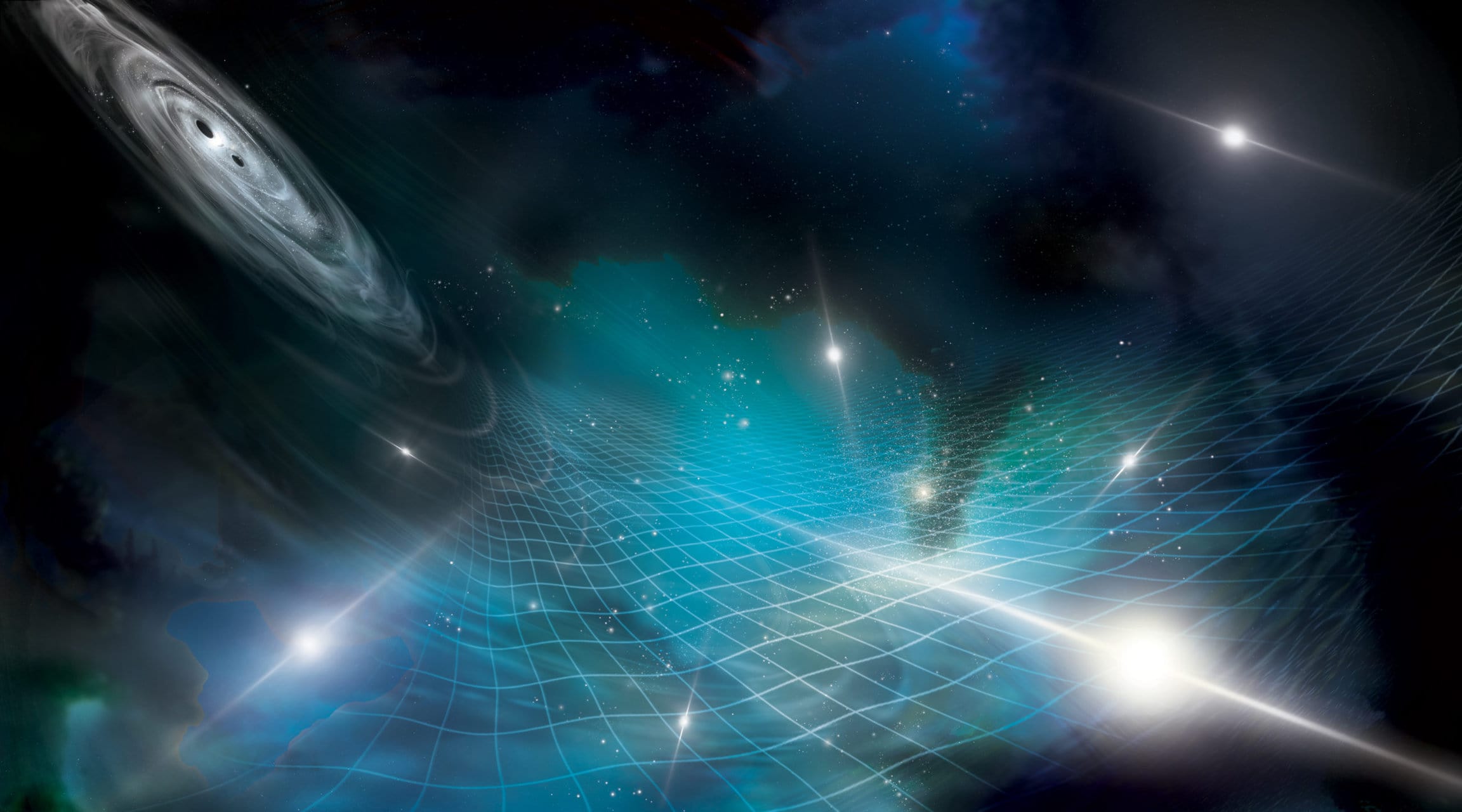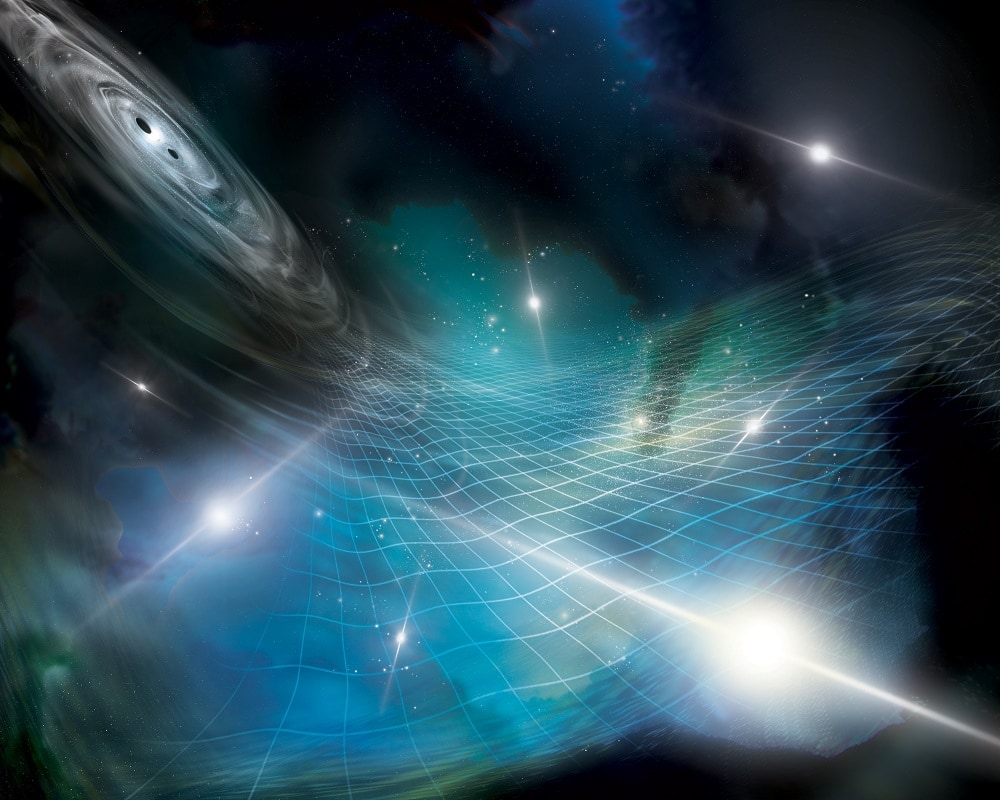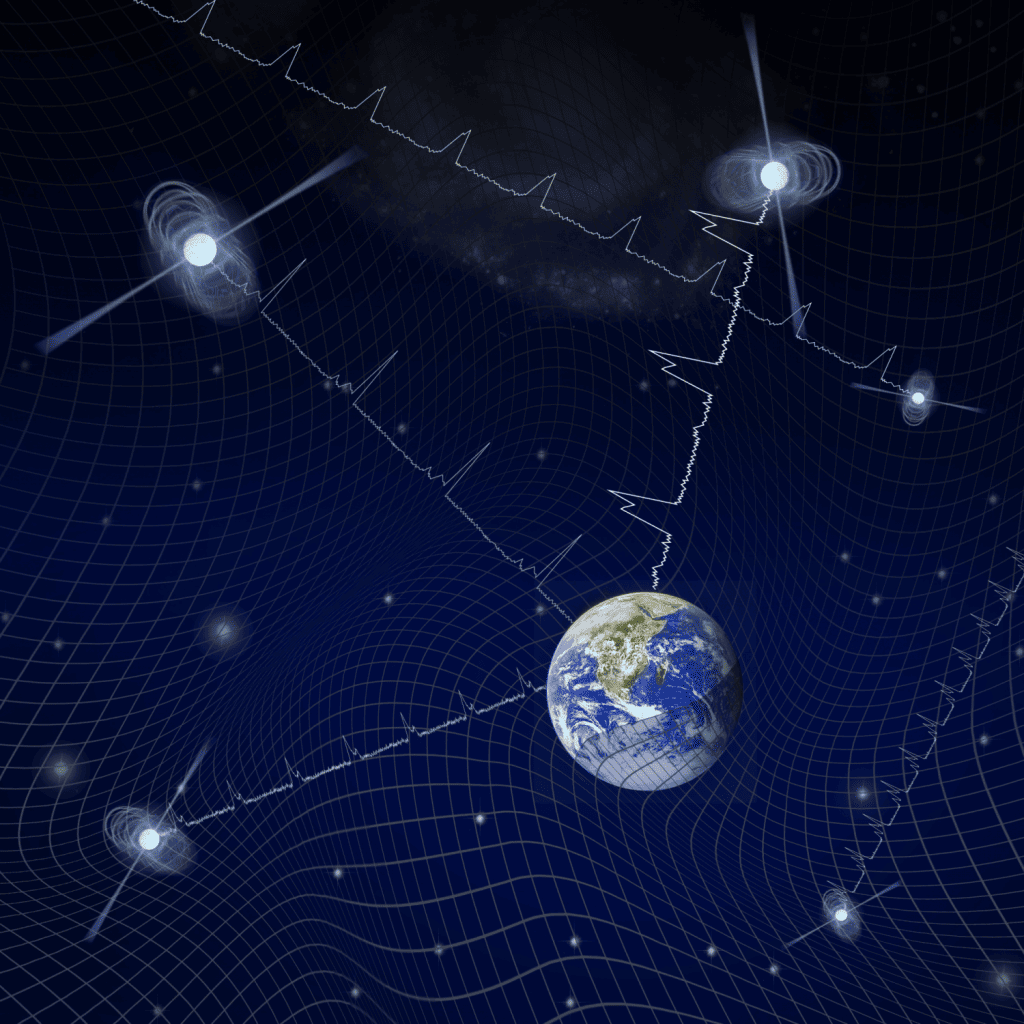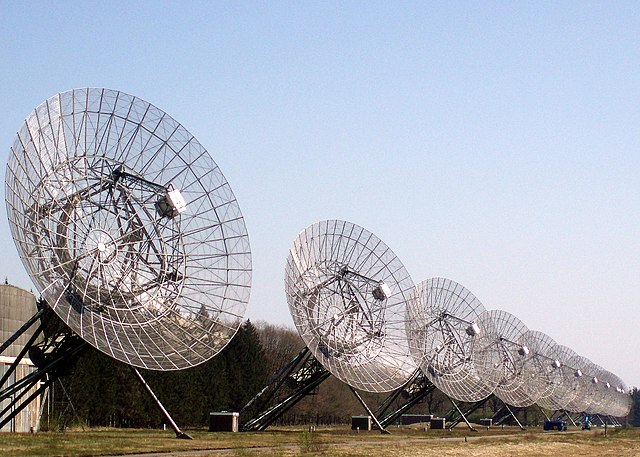
Strong evidence of gravitational waves from the merger of supermassive black holes
We are floating on a sea of gravitational waves, caused by countless pairs of supermassive black holes slowly merging together. Thanks to years of careful measurements by cosmic beacons, astronomers have now almost conclusively proven the existence of these background waves.
Astronomers may have measured gravitational waves from merging supermassive black holes for the first time. Over decades of observing spinning neutron stars, they’ve discovered the ripples in space-time that many of these cosmic pairs combine to create. This ‘sea of gravitational waves’ could provide new insights into, among other things, the origin of dark giants.
The results of the research were presented today by five astronomical collaborations that form together International pulsar timing set Models: European EPTA, Indian InPTA, Australian PPTA, Chinese CPTA and American NANOGrav. They are also described in a series of articles in trade journals Astrophysical Journal Letters.
Read also
Venus and Mars are testing grounds for our climate models
What role do we humans play in global climate change? According to astrobiologist David…
dans cosmic
Gravitational waves are vibrations in space-time, similar to the waves you see when you throw a rock into a pond. They arise during violent cosmic events such as the collision of black holes.
In recent years, about ninety gravitational waves have been measured by the LIGO and Virgo detectors. These are all waves several kilometers long. Most of them are formed in collisions between stellar black holes, which are the compact remnants of massive stars that have exploded. The size of this black hole is at most a few tens of times the mass of the sun.
There are also supermassive black holes. They are located in the centers of galaxies and are millions to billions of times as massive as the Sun. These formidables sometimes bump into each other. In many places in the universe there are galaxies that slowly rotate towards each other and eventually merge.
Gravitational waves are also released during such a cosmic dance. Although it is a million times more powerful than the waves generated by small collisions, it cannot be measured yet. These types of waves are at least a few light years across. This is accompanied by a very low frequency: there are sometimes decades between the top and the bottom, and as a result, these gravitational waves are outside the range of LIGO and Virgo.
musical background
Astronomers have not measured gravitational waves from a specific pair of supermassive black holes. They found evidence of a combined signal of all kinds of long wavelengths, which originated from lots of cosmic mergers. Together, these gravitational waves make up a kind of ubiquitous background music in the universe – the gravitational wave wallpaper (GWB).

In recent years, astronomers have come close to discovering the GWB. The NANOGrav researcher says the chance that they only measured noise by mistake is now less than 1 in 1,000 for all datasets, and even less than 1 in 10,000 for some datasets. Stephen Taylor. This is not yet beyond the statistical limit at which you can officially speak of a “discovery” – which is 1 in 3.5 million. So the researchers are now postponing certificate, or “guideline”. But Taylor expects the milestone to be reached soon when measurements from the different teams are combined.
Chris Van Den Broeck, gravitational-wave researcher at Utrecht University and the Amsterdam Institute of Physics Nikhef, we hope that soon we will be able to talk about a real discovery. “I think we’re close to that. I’m really excited about this, I find it very exciting,” he says.
archeology
Background gravitational waves provide astronomers with a new window into the universe. It roughly shows how many pairs of supermassive black holes there are and what their mass is. Nanograph researcher Claire Mingarelli It is estimated, based on current data, that the universe may contain more than a million such pairs.
Van Den Broeck compares this type of research to archeology. “Only when you find enough different things can you say something about a particular culture,” he says. With LIGO and Virgo, and soon with the Einstein telescope, we can study even smaller black holes. with this Pulsar timing arrays We can study supermassive black holes that are still quite far apart. If LISA joins them later, we can also see their merging moment.
From all of these measurements taken together, astronomers hope to infer how supermassive black holes got their gigantic proportions. Because this has been a great mystery until now. Was it really big when it came into existence? Or were they the first stellar-mass black holes, and did they become progressively larger through all kinds of mergers? We don’t know which way the universe chose,” says van den Broeck.
By simulating different versions of the universe, with different types of black holes, astronomers may be able to unravel this mystery. Then they can compare the ELV signal seen in that simulation with the real signal.
Silent disco
The ELV was discovered thanks to very precise measurements of pulsars. These are neutron stars that spin at lightning speed — almost as fast as a blender. Because of this rotation, they are a kind of cosmic beacon: once every few milliseconds they send a beam of radio waves towards Earth.
Usually the time between two signals is exactly the same. When we measure an anomaly on Earth, something must have happened in the area between us and the pulsar. One possibility is that the passing gravitational wave warped space-time. In this case, the radio signals take temporarily shorter or longer to reach us.

You can compare this method of measurement with watching a file Silent disco. If someone starts dancing to a different beat with headphones on, you know the background music has changed somehow, even though you can’t hear it yourself. Likewise, deviations in the rhythm of pulsar signals could betray the presence of an ELV.
However, the time deviations caused by gravitational waves are less than a millionth of a second. This makes it very difficult to measure. Furthermore, not every deviation has to be caused by an ELV. For example, a pulsar’s signal on its way to Earth may be delayed by a passing cloud of gas. So you only have evidence of background waves when several pulsars far apart exhibit the same anomaly. Then it is as if several silent discogo buffs will dance to the same new scale.
individual tools
With all kinds of radio telescopes around the world incl Westerbork Radio Tuning Telescope From the Dutch institute ASTRON, astronomers have studied for years Pulsar timing arrays: Clusters of dozens of pulsars are scattered across the Milky Way. The teams independently looked at different groups of pulsars. They all found strong indications for the presence of GWB.

Eventually, the researchers also expect to detect gravitational waves from specific pairs of supermassive black holes via pulsar signals. “The initial data told us we had heard something. Now we know this is the music of the gravitational universe,” says the astrophysicist. Xavier Simmons, co-director of NANOGrav. “If we keep listening, individual instruments will also appear in this cosmic orchestra.”
cosmic inflation
It is not yet certain that the combined signal of gravitational waves is due entirely to the merger of supermassive black holes. “GWB sounds twice as loud as I expected,” says Mingarelli.. “It’s really close to the limit of what our computer models would produce if only supermassive black holes contributed.”
This leaves room for the intriguing option that the signal also contains signs of primordial gravitational waves. These are powerful waves that must have arisen within a fraction of a second after the Big Bang, when the universe went through a period of rapid growth. Measuring primordial gravitational waves will provide the first direct evidence of this cosmic inflation.
According to Van den Broeck, such a discovery is comparable to the discovery of cosmic background radiation. This is radiation that originated about 380,000 years after the Big Bang and is still measurable everywhere, so it gives astronomers a lot of insight into the early universe. “I certainly hope to find primordial gravitational waves, because they originated in a much shorter time after the Big Bang,” says Van den Broeck. “But even if it is a component of the signal, it will be many years before we can discern it.”
great bounce
In addition, there are theoretically more exotic sources of elongated gravitational waves that could be contributing to the signal. Primordial black holes, for example: tiny black holes that may have formed within seconds of the Big Bang. Or cosmic strings: a type of crack in space-time that, according to string theory, originated in the early universe. Or the collapse of the previous universe, from which, according to the Big Bounce theory, the current one arose.
These types of theories are often highly speculative and still impossible to prove or disprove. The GWB investigation likely won’t change that anytime soon. Still, the NANOGrav researcher believes Luke Kelly That it can help these theories further. “Even if these phenomena don’t contribute to the signal, the measurements allow us to subject these kinds of theories to more stringent conditions,” he says.

“Web maven. Infuriatingly humble beer geek. Bacon fanatic. Typical creator. Music expert.”
